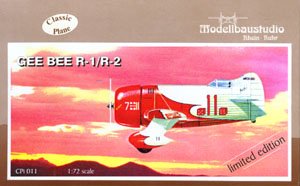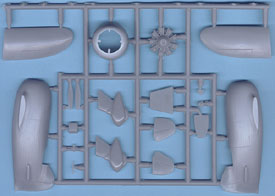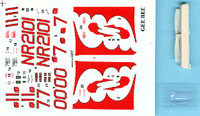


 Classic
Plane's 1/72
Classic
Plane's 1/72
Gee Bee R-1/R-2 Racer
By Chris Banyai-Riepl
History
When most people walk into a dance hall, they expect to dance. But when Zantford D. Granville and his brothers walked into a dance hall in Springfield, Massachusetts, their thoughts were on something completely different: the Super Sportster R-1. Built in that dance hall, the Super Sportster, popularly known as the Gee Bee, was little more than a winged shell for a powerful Pratt & Whitney radial engine. A short wingspan and an even shorter vertical tail made this plane squirrelly at best, a fact borne out by both models crashing. A third Gee Bee, built from the salvaged parts of the first two, also crashed. But before the Gee Bee disappeared from the racing scene, daredevil Jimmy Doolittle flew it to a new world record of 309mph at Cleveland in September 1932. The next day, at the Thompson Trophy races, Doolittle and the Gee Bee again captured attention and another record, finishing the race first at an average speed of 252.7mph.
The Kit
I remember the old Hawk (later Testors) kit of the Gee Bee from my childhood
and I always had an interest in the plane. But since the Hawk/Testors
kit was in 1/48 and I  build
almost exclusively 1/72, I thought I'd never add an injection plastic
Gee Bee to my collection. Classic Plane has changed that with this kit,
and it's a very nice addition indeed. A vacuformed canopy, a resin propeller,
and a single tree of injection plastic parts are all that make up this
kit. The simplicity will make this an easy one-day project to build, unless
you want to really go to town on the engine. The cockpit is adequately
detailed with a floor, seat, headrest and instrument panel. You could
add more, but with a cockpit opening measuring only 3/10ths of an inch
long and 1/5 wide, you aren't going to see much.
build
almost exclusively 1/72, I thought I'd never add an injection plastic
Gee Bee to my collection. Classic Plane has changed that with this kit,
and it's a very nice addition indeed. A vacuformed canopy, a resin propeller,
and a single tree of injection plastic parts are all that make up this
kit. The simplicity will make this an easy one-day project to build, unless
you want to really go to town on the engine. The cockpit is adequately
detailed with a floor, seat, headrest and instrument panel. You could
add more, but with a cockpit opening measuring only 3/10ths of an inch
long and 1/5 wide, you aren't going to see much.
The wings are solid, as are the tailplanes and landing gear. Painting
the wheels apart from the spats will be difficult, but other than that
things shouldn't be too hard. The  only
step left is painting the plane, and it's here that most people shy away
from doing a Gee Bee. The neat scalloped paint scheme on this plane is
not an easy one to paint and Classic Plane has made that somewhat easier
to accomplish. By including the scalloping of the wings and wheel pants
as decals, finishing this model becomes much easier. The only scalloping
you'll have to paint is that on the fuselage, and that is much easier
to handle than the wings. I haven't looked yet, but it shouldn't be too
hard to find a paint match for the decal red. If you can't decide which
Gee Bee to build, the decal sheet doesn't make things any easier as it
includes a full set of markings for both Gee Bees.
only
step left is painting the plane, and it's here that most people shy away
from doing a Gee Bee. The neat scalloped paint scheme on this plane is
not an easy one to paint and Classic Plane has made that somewhat easier
to accomplish. By including the scalloping of the wings and wheel pants
as decals, finishing this model becomes much easier. The only scalloping
you'll have to paint is that on the fuselage, and that is much easier
to handle than the wings. I haven't looked yet, but it shouldn't be too
hard to find a paint match for the decal red. If you can't decide which
Gee Bee to build, the decal sheet doesn't make things any easier as it
includes a full set of markings for both Gee Bees.
Conclusion
The Gee Bee is easily one of the most recognizable planes to come out of the 1930s racing scene and it's great to finally have a 1/72 injection plastic kit of one. It's really tempting to build this one up and put Jimmy Doolittle in the cockpit, shooting around the final corner for his Thompson Trophy win. If you've always wanted to build a Gee Bee but were waiting for a 1/72 kit, definitely pick this gem up.

Previous: Contents







